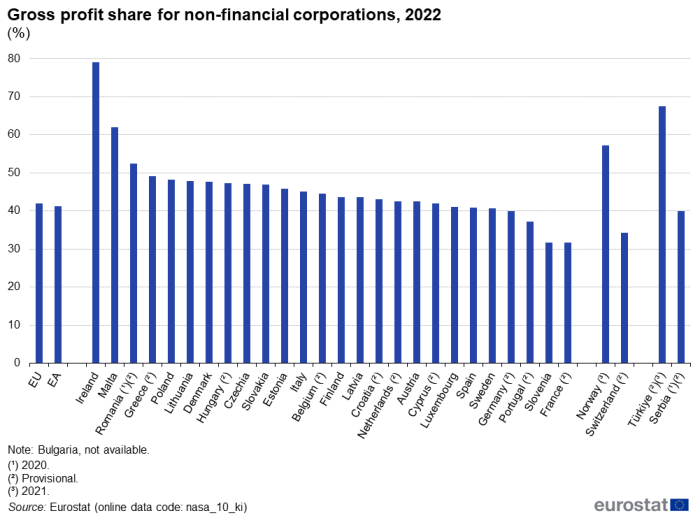Business - statistics on profits and investment
Data extracted in November 2023.
Planned article update: November 2024.
Highlights
In 2022, non-financial corporations in the EU had a profit share of 42.1 % and an investment rate of 23.8 %.
In 2022, profit shares of non-financial corporations varied among the EU Member States from 31.7 % in France to 79.1 % in Ireland.
In 2022, the investment rate of non-financial corporations varied among the EU Member States from 15.4 % in Luxembourg to 33.9 % in Hungary.
Gross investment rate of non-financial corporations (businesses), 2022
Economic developments in production, income generation and (re)distribution, consumption and investment may be better understood when analysed by institutional sector. In particular, the European Union's (EU's) sector accounts provide several key indicators for non-financial corporations (also referred to as businesses), like the business profit share.
This article focuses on the distribution of profit and investment for non-financial corporations in the European Union (EU) and the euro area (EA). Note that there are complementary articles that provide information on financial assets and liabilities for non-financial corporations and for income, saving and investment for households.
The non-financial corporations sector comprises all private and public corporate enterprises that produce goods or provide non-financial services to the market.
This article presents Eurostat statistics derived from European sector accounts, which form part of the European system of national and regional accounts (ESA 2010). Data are provided for the EU and the euro area, as well as for individual EU Member States, some of the EFTA and enlargement countries for the latest reference year available and for developments over the previous 10 years.
The time period covered by the analyses in this article is 2012 to 2022. When looking at developments during this period, it should be remembered that the global financial and economic crisis had a major impact on economies and societies in the EU. As such, the starting point for the time series that are presented is a year (2012) with a relatively low level of economic activity, in real terms still 1.1 % below the 2008 pre-crisis peak. The time series ends in 2022, which was the third year of the COVID-19 pandemic, which also had a major impact on economies and societies. Furthermore, the final year in the period under consideration was also during the current period of relatively high price increases (the cost-of-living crisis). The annual inflation rate in the EU was 9.2 % in 2022, far higher than in any other year since the time series began in 2001; the next highest rate was 3.7 % in 2008.
Within this article, most indicators are presented in relation to gross value added. This standardisation is beneficial for making spatial comparisons, especially between EU Member States or non-member countries of different sizes.
Full article
Value added is the value generated by the production process. Figure 1 shows that most of the value added of non-financial corporations is used to reward the supply of labour and capital, referred to in national accounts terms as the compensation of employees and gross operating surplus. Gross operating surplus is a measure of profit (before taxes on income and wealth) and may include the remuneration of self-employed persons in countries where the self-employed are included in the non-financial corporations sector (rather than the household sector). A small part of value added is used to pay taxes on production (less subsidies).
The profit share of non-financial corporations is defined as gross operating surplus divided by gross value added. As such, this profitability indicator shows the proportion of the value added by non-financial corporations during the production process which remunerates the supply of capital (or pays income and wealth taxes). Different profit shares in different economies can be explained by a number of factors, such as the relative importance of labour or capital-intensive industries, labour productivity and the level of labour costs.
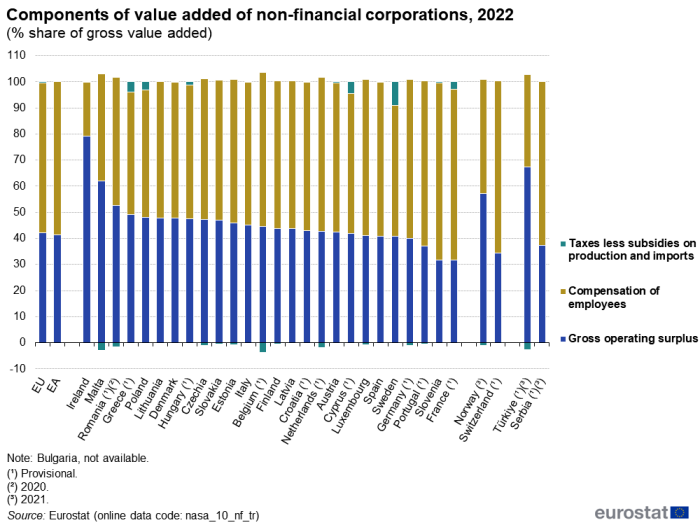
(% share of gross value added)
Source: Eurostat (nasa_10_nf_tr)
In 2022, profit shares were slightly higher in the EU (42.1 %) than in the euro area (41.3 %). Among the four largest EU economies, Italy (45.1 %) had the highest profit share for non-financial corporations in 2022, the only one above the EU average. The profit shares of Spain (40.8 %), Germany (39.9 %) and France (31.7 %) were all relatively low. In fact, the profit share in France was the lowest share recorded among all EU Member States. In three Member States, the gross operating surplus of non-financial corporations represented more than half of the gross value added during the production process: in Romania (2020 data) and Malta, the shares were 52.5 % and 62.0 %, respectively; in Ireland, the share was 79.1 %. The high share in Ireland is mainly due to large foreign-owned multinational companies that pay a relatively small proportion of their labour costs in Ireland.
Figure 3 shows the absolute change between 2012 and 2022 in profit shares for non-financial corporations. This time span starts during the recovery after the global financial and economic crisis and runs into the third year of the COVID-19 crisis as well as the beginning of the current period of relatively high price increases (the cost-of-living crisis).
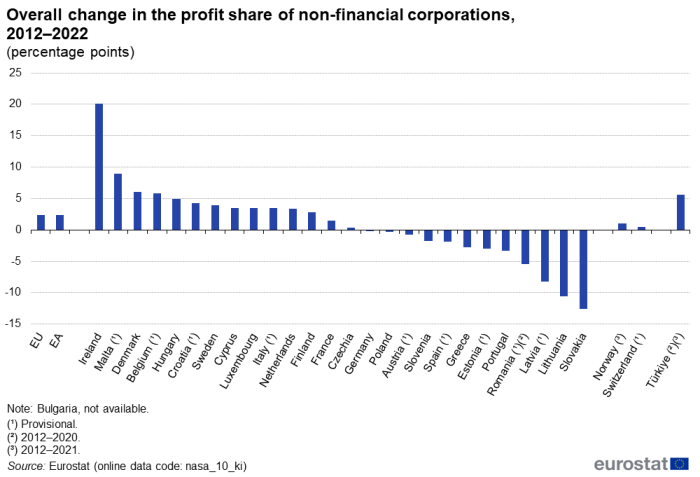
(percentage points)
Source: Eurostat (nasa_10_ki)
In the EU and the euro area, profit shares of non-financial corporations were, respectively, 2.3 percentage points and 2.4 pp higher in 2022 than they had been in 2012.
Among the four largest economies of the EU, the profit share for non-financial corporations increased between 2012 and 2022 in Italy (up 3.4 pp) and France (up 1.5 pp), while it fell in Germany (down 0.2 pp) and Spain (down 1.8 pp). Across all EU Member States, the largest rise by far in the profit share was observed in Ireland (up 20.1 pp), while the next largest rise was 8.9 pp in Malta. The largest falls were reported for Latvia (down 8.2 pp), Lithuania (down 10.5 pp) and Slovakia (down 12.6 pp).
A time series of profit shares between 2012 and 2022 is provided in Table 1 of the annex; see the link later in this article.
Distribution of gross operating surplus
The gross operating surplus of non-financial corporations is mainly used to pay taxes on income and wealth and to remunerate capital, for example in the form of interest or dividends paid to shareholders. In addition, non-financial corporations also receive interest and other property income from their financial investments, for example also in the form of dividends or reinvested earnings. After accounting for these payments and income as well as other miscellaneous current transfers, the remainder of the gross operating surplus is available as the saving of non-financial corporations. This may be used for example for investment, for other capital transactions, or to be lent; if the investment and other capital transactions exceed savings, then borrowing occurs.
Figure 4 shows non-financial corporations' gross operating surplus, how it is distributed and the resulting net lending (if positive) or net borrowing (if negative). Total net distributions (taxes, interest, other property income/expenditure, other current transactions and capital transactions) generally correspond to the full bar below the horizontal axis. In 2022, total net distributions in the EU represented -40.6 % of value added.
In 2022, there were seven EU Member States with a positive net balance for some types of distributions. This was the case for other current transactions, most notably in Poland, Hungary and Luxembourg. Norway also had a positive balance for other current transactions. The Netherlands was the only Member State to have a positive balance for capital transactions.
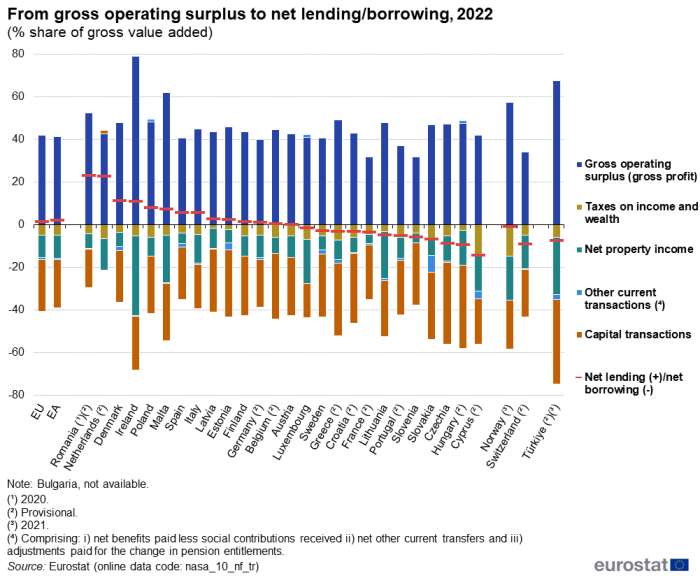
(% share of gross value added)
Source: Eurostat (nasa_10_nf_tr)
Among the EU Member States, total net distributions by non-financial corporations in 2022 were largest in Ireland (-68.2 % of value added). In all other Member States, total net distributions were smaller than -60.0 % of value added. The lowest total net distributions relative to value added were reported for the Netherlands (-19.8 %). Among the non-EU countries shown in Figure 4, a relatively high ratio of total net distributions to value added was observed in Norway (-58.2 %; 2021 data) and a particularly high one in Türkiye (-74.8 %; 2021 data).
Leaving aside capital transactions (see below) and looking at the individual types of current distributions, the largest share for non-financial corporations in 2022 was generally for net property income. In the EU, net property income was equivalent to -10.5 % of value added, thereby accounting for more than three fifths of all net current distributions (taxes on income and wealth, net property income and other current transactions). Table 4 in the annex provides more detailed information; see the link later in this article.
In the EU, the vast majority of net property income other than interest in 2022 was distributed income of corporations: this heading accounted for 89.9 % of the payments and 79.2 % of the receipts of all property income other than interest. By contrast, reinvested earnings on direct foreign investment made up 8.2 % of payments and 18.4 % of the receipts, while property income attributed to insurance policy holders and rents each made up at most 1.9 % of payments and at most 2.2 % of receipts of property income other than interest.
The ratio of net property income other than interest to value added was particularly large in Ireland (-34.2 %), Lithuania (-21.7 %), Malta (-21.3 %) and Luxembourg (-19.3 %) among the EU Member States.
The remaining component of net property income is net interest. In 2022, net interest was equivalent to -0.4 % of value added of non-financial corporations in the EU. Among the EU Member States, Poland, Latvia, Estonia, Slovenia, Germany, Greece and France recorded positive values for net interest (at most 0.8 % of value added), meaning that their non-financial corporations received more interest income than interest paid. In the Netherlands, payments and receipts of interest were approximately equal. Elsewhere in the EU, this ratio was generally less than -2.0 % of value added. Larger negative ratios of net interest relative to value added were observed in Finland (-2.4 %), Ireland (-3.3 %), Denmark (-3.3 %) and Cyprus (-5.7 %).
Taxes on income and wealth were equivalent to -4.9 % of non-financial corporations' value added in the EU; see Figure 4. Such taxes were therefore the second largest component of net current distributions, behind net property income other than interest.
Three EU Member States – Cyprus, Denmark and France – reported that taxes on income and wealth accounted for a larger (negative) share of net current distributions than property income other than interest. Cyprus recorded the largest ratio of taxes on income and wealth to value added among all of the Member States, at -14.1 %, followed by Greece (-7.3 %). The ratio of taxes on income and wealth to value added was smaller than -3.5 % of value added in the three Baltic Member States and Hungary.
Investment rates
Investment is the largest part of capital transactions. The investment rate for non-financial corporations presented in Figures 5 to 7 shows investments in fixed assets (mainly machinery and buildings) as a percentage of value added in the production process. In 2022, the investment rate was marginally higher in the EU (23.8 %) than in the euro area (23.3 %); see Figure 5.
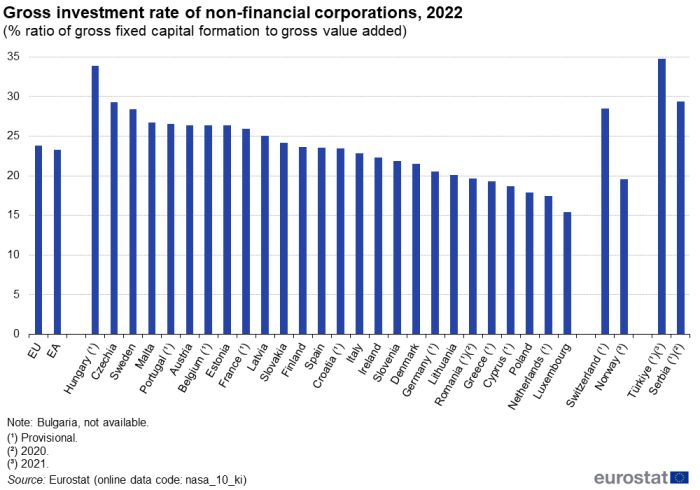
(% ratio of gross fixed capital formation to gross value added)
Source: Eurostat (nasa_10_ki)
Among the four largest EU economies, the investment rate for non-financial corporations in 2022 was above the EU average (23.8 %) in France (25.9 %), while this rate was below the EU average in Spain (23.6 %), Italy (22.9 %) and Germany (20.6 %). Six EU Member States reported rates below 20.0 %, with the lowest rate in Luxembourg (15.4 %). Hungary reported the highest rate (33.9 %), followed by Czechia (29.3 %) and Sweden (28.4 %). The disparity of investment rates between different economies can be partly explained by structural differences, for example the relative importance of capital-intensive activities.
Investment rates between 2012 and 2022
Although annual investments may be volatile for individual enterprises, cyclical trends can be observed nationally. Figure 6 shows investment rates for the four largest EU economies as well as the EU and euro area averages.
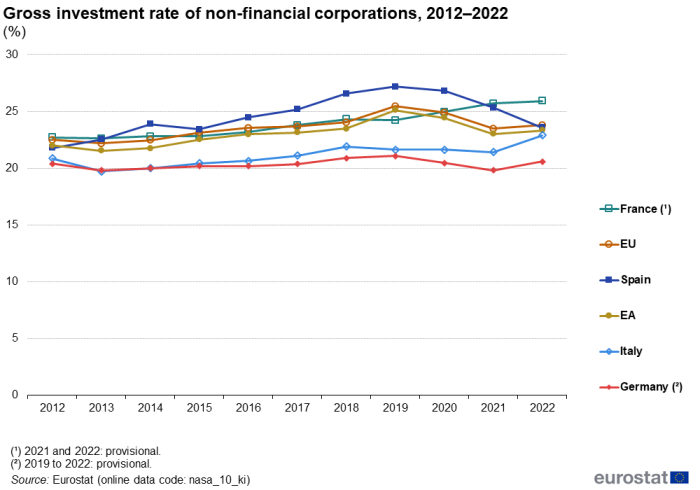
(%)
Source: Eurostat (nasa_10_ki)
In 2013, developments for investment rates of non-financial corporations were quite varied among the largest EU economies. France recorded almost no change (down 0.1 pp), while Germany and particularly Italy recorded stronger decreases. By contrast, Spain recorded an increase. In the five years from 2014 to 2018, all of these economies recorded annual increases in their respective investment rates, with the exception of a fall in 2015 in Spain. In 2019, the investment rate increased in Spain and Germany, while there were relatively modest falls in France and Italy. As the COVID-19 crisis started, almost the reverse situation was observed, with only France recording an increase in its investment rate in 2020. In 2021, the situation was similar, with falls in the investment rates of Italy, Germany and Spain. In 2022, France recorded its third consecutive increase and Spain its third consecutive decrease, while Germany recorded an increase for the first time since 2019 and Italy for the first time since 2018.
Between 2012 and 2022, the largest increase (among the four largest EU economies) in the investment rate of non-financial corporations was recorded in France, with an overall increase of 3.2 pp. During the same period, the investment rate increased 2.0 pp in Italy and 1.8 pp in Spain. The overall increase in the euro area and in the EU was 1.3 pp A smaller increase was recorded in Germany (up 0.2 pp).
A time series of investment rates between 2012 and 2022 is provided in Table 2 of the annex; see the link later in this article.
Figure 7 shows the overall change in the investment rate of non-financial corporations between 2012 and 2022, calculated in percentage point terms. Among the EU Member States (no data for Bulgaria), Hungary recorded the most substantial increase in its investment rate (up 10.1 pp from 23.9 % in 2012 to 33.9 % in 2022). Malta (up 6.8 pp) and Portugal (up 6.1 pp) reported the next highest increases. Increases were recorded in 14 other Member States. Romania reported a fall of 12.3 pp, from 32.0 % in 2012 to 19.7 % in 2020 and Luxembourg a fall of 10.4 pp between 2012 and 2022. The next largest fall between 2012 and 2022 was 4.6 pp in Ireland.
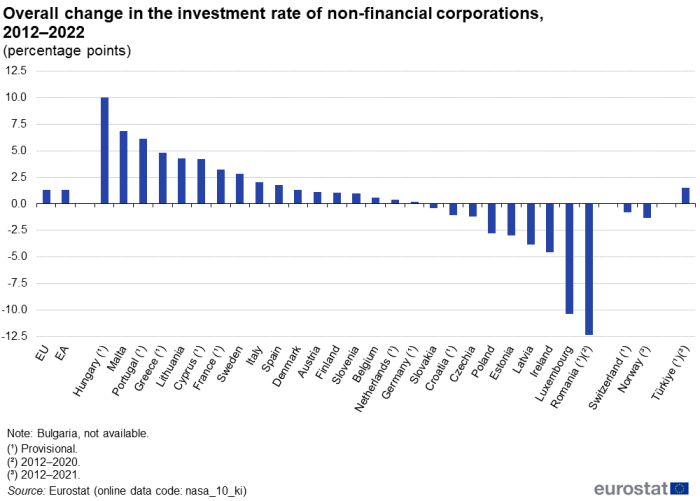
(percentage points)
Source: Eurostat (nasa_10_ki)
Financing investment: net lending and borrowing
Non-financial corporations' savings and net borrowing (or lending) are used to finance gross capital formation, other capital transfers and acquisitions less disposals of non-financial non-produced assets. Gross capital formation includes gross fixed capital formation (referred to elsewhere in this article as investment), changes in inventories, and acquisitions less disposals of valuables. Non-financial non-produced assets concern, for example, land, mineral reserves or radio spectra.
The difference between savings and all capital transactions is called net lending or net borrowing, depending on whether it is positive or negative. If non-financial corporations are net lenders, it means that they have an excess of savings over investment and other capital transactions that they can lend to other sectors of the national economy or to non-residents. Conversely, they are net borrowers when they need to borrow money from other sectors to supplement their savings in order to finance their investment and other capital transactions.
In 2022, non-financial corporations in the EU and the euro area were net lenders, with their net lending valued at 1.5 % and 2.3 % of value added, respectively; see Figure 8.
Non-financial corporations in three of the four largest EU economies were also net lenders in 2022, the exception being France (net borrowing of 3.3 % of value added). The ratio of net lending to value added was highest in Spain and Italy (both 5.8 % of value added), while it was below the EU average in Germany (1.1 %).
A time series between 2012 and 2022 of the ratio of net lending/borrowing relative to gross value added of non-financial corporations is provided in Table 5 of the annex; see the link later in this article.
In 2022, the highest ratios of non-financial corporations' net lending to value added among all of the EU Member States (no recent data for Bulgaria) were recorded in Romania (23.2 %; 2020 data), the Netherlands (22.8 %), Denmark (11.4 %) and Ireland (10.9 %). A further 10 Member States reported net lending of 8.1 % of value added or less. In 12 Member States, non-financial corporations were net borrowers, with the highest ratio in Cyprus (-14.2 %).
Non-financial corporations in the EU were net lenders every year from 2012 to 2017 but moved to being net borrowers in 2018 and 2019, before reverting to being net lenders again from 2020 to 2022. For the euro area, the situation was similar.
The developments for non-financial corporations' net lending/borrowing between 2012 and 2022 were diverse among the four largest economies of the EU. In France, non-financial corporations remained net borrowers throughout most of this period, with net lending in 2016 (on a very small scale) and 2021 the only exceptions. The reverse was largely true in the three other large economies:
- in Italy, net borrowing was recorded only in 2015 (on a very small scale);
- in Germany, net lending was recorded every year, with the rate of net lending higher than in Italy each year from 2012 to 2017 and again in 2019 and 2021;
- in Spain, net lending was recorded every year and this at a rate above all of the other three largest economies from 2012 to 2019 and again in 2022.
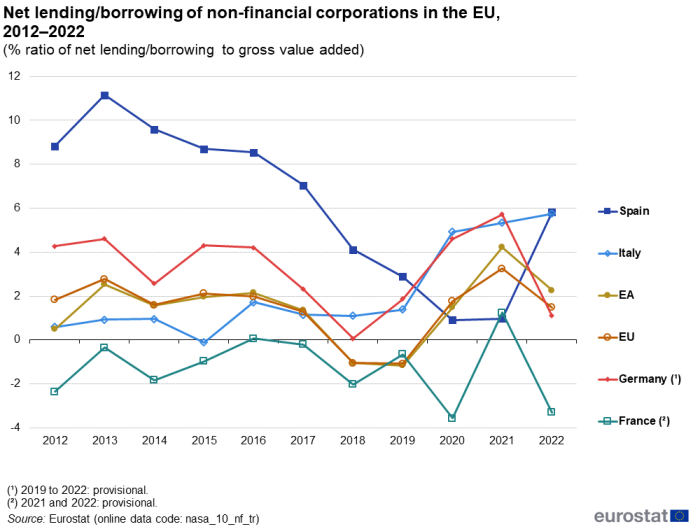
(% ratio of net lending/borrowing to gross value added)
Source: Eurostat (nasa_10_nf_tr)
Source data for tables and graphs
Data sources
The compilation of sector accounts follows the European system of accounts (ESA 2010). It provides the basis for all of the data for the EU Member States, EFTA countries and enlargement countries, as collected by the European Central Bank (ECB) and Eurostat. Together, they publish integrated non-financial and financial accounts, including financial balance sheets, for the euro area. Eurostat also publishes the non-financial accounts of the EU.
The non-financial accounts
Non-financial accounts provide a systematic description of the different stages of the economic process: production, generation and distribution, use and accumulation of income. Each of the accounts ends with a balancing item: value added, operating surplus, primary income, disposable income, saving. In case of non-financial corporations some of these can be seen as profit measures.
The data presented in this article do not take account of profits/losses caused by changes in the price levels of assets or by extraordinary events (such as catastrophic losses). Profit measures may be calculated either gross or net of depreciation (called consumption of fixed capital in national accounts): in this article all indicators are presented gross of the consumption of fixed capital.
The non-financial corporations sector
Institutional sectors within national accounts bring together economic units with broadly similar characteristics and behaviour. The non-financial corporations sector is one of five sectors – along with financial corporations, general government, households and non-profit institutions serving households – that together make up the domestic economy.
The non-financial corporations sector consists of institutional units which are independent legal entities and market producers, and whose principal activity is the production of goods and non-financial services. It may be divided into three subsectors covering: public non-financial corporations, national private non-financial corporations and foreign controlled non-financial corporations.
In general, sole proprietorships and most partnerships that do not have an independent legal status are considered to be part of the household sector, rather than corporations (financial or non-financial). However, there are sometimes practical difficulties in delineating 'quasi-corporations' (unincorporated businesses with the characteristics of companies) between corporations on one hand and the household sector on the other. This may influence the scope and comparability of the data presented as well as the internal consistency of the full set of accounts.
Indicator definitions
The profit share of non-financial corporations is defined as the gross operating surplus divided by gross value added. This profitability indicator shows the share of the value added created during the production process that is used to remunerate capital. It is the complement of the remuneration of labour (known in national accounts as compensation of employees) which accounts for most of the remainder of value added; the residual amount relates to taxes less subsidies on production and imports.
The gross investment rate of non-financial corporations is defined as gross fixed capital formation divided by gross value added. This ratio relates the investment in fixed assets (such as buildings, machinery, software and major improvements to fixed assets) to the value added created during the production process.
Context
Non-financial sector accounts form part of the national accounting framework and are compiled in the EU in accordance with the European system of national and regional accounts (ESA 2010). They are an indispensable tool for analysing developments concerning production, the distribution of income, savings and investment by various institutional sectors, including non-financial corporations.
Issues relating to the non-financial corporations sector include measures of profit and investment as well as the overall level of net lending or borrowing.
Since the beginning of the economic and monetary union (EMU) in 1999, the ECB has been one of the main users of national accounts. A large number of monetary and financial indicators are evaluated in relation to other relevant data that allow the combination of monetary, financial and economic analyses, for example, through key national accounts aggregates and sector accounts. In this way, monetary and financial indicators can be analysed within the context of the rest of the economy.
The investment rate for the total economy and for individual institutional sectors is a key indicator for economic analysis and EU policymaking, in particular in the context of monitoring EU Member States' economies under the European Semester, for example, country specific recommendations / European Commission recommendations.
The investment rate is also part of the principal European economic indicators (PEEIs).
Financial institutions' interest in national accounts may range from a broad analysis of the economy to specific information concerning savings, investment or debt among households, non-financial corporations or other institutional sectors.
Like all sectors of the economy, non-financial corporations were directly and indirectly impacted by the COVID-19 pandemic and its related restrictions. The multiannual financial framework covering the period 2021–2027 adopted in December 2020 is being supported by a supplementary budget called the European Recovery Instrument (also known as Next Generation EU). This mainly concerns the Recovery and Resilience Facility, a small majority of which will be disbursed as loans and the rest as grants. This facility provides support for reforms and investments undertaken by EU Member States. Its aim is to mitigate the economic and social impact of the COVID-19 pandemic and make EU economies and societies more sustainable, resilient and better prepared for the challenges and opportunities of the green and digital transitions.
Direct access to
- Key indicators - annual data (nasa_10_ki)
- Non-financial transactions - annual data (nasa_10_nf_tr)
